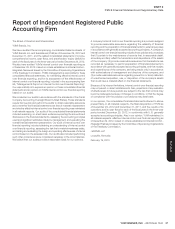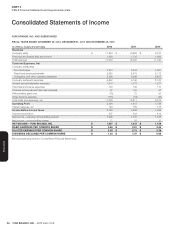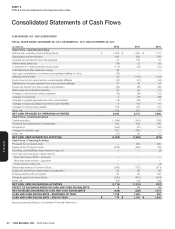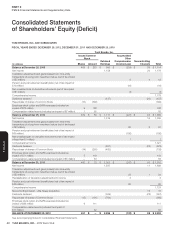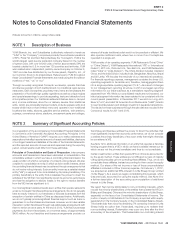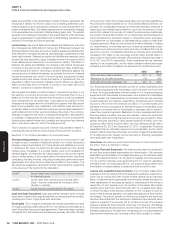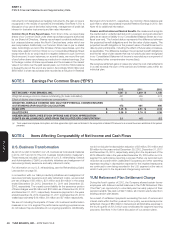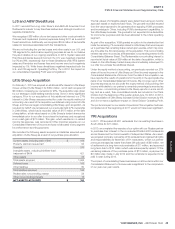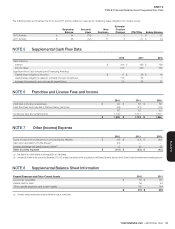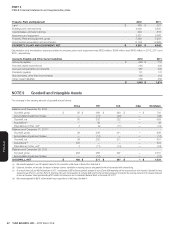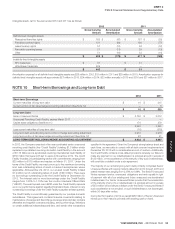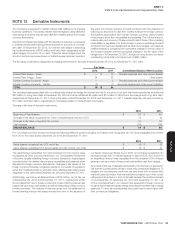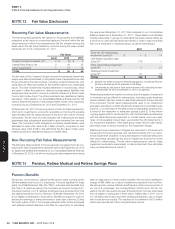Pizza Hut 2012 Annual Report Download - page 139
Download and view the complete annual report
Please find page 139 of the 2012 Pizza Hut annual report below. You can navigate through the pages in the report by either clicking on the pages listed below, or by using the keyword search tool below to find specific information within the annual report.
YUM! BRANDS, INC.-2012 Form10-K 47
Form 10-K
PART II
ITEM 8Financial Statements andSupplementaryData
We expense rent associated with leased land or buildings while a restaurant
is being constructed whether rent is paid or we are subject to a rent
holiday.Additionally, certain of the Company’s operating leases contain
predetermined fi xed escalations of the minimum rent during the lease
term.For leases with fi xed escalating payments and/or rent holidays,
we record rent expense on a straight-line basis over the lease term,
including any option periods considered in the determination of that lease
term.Contingent rentals are generally based on sales levels in excess of
stipulated amounts, and thus are not considered minimum lease payments
and are included in rent expense when attainment of the contingency is
considered probable (e.g. when Company sales occur).
Internal Development Costs and Abandoned Site Costs.We capitalize
direct costs associated with the site acquisition and construction of a
Company unit on that site, including direct internal payroll and payroll-
related costs.Only those site-specifi c costs incurred subsequent to the
time that the site acquisition is considered probable are capitalized.If we
subsequently make a determination that it is probable a site for which
internal development costs have been capitalized will not be acquired
or developed, any previously capitalized internal development costs are
expensed and included in G&A expenses.
Goodwill and Intangible Assets.From time to time, the Company
acquires restaurants from one of our Concept’s franchisees or acquires
another business.Goodwill from these acquisitions represents the excess
of the cost of a business acquired over the net of the amounts assigned
to assets acquired, including identifi able intangible assets and liabilities
assumed.Goodwill is not amortized and has been assigned to reporting
units for purposes of impairment testing.Our reporting units are our
operating segments in the U.S. (see Note18), our YRI business units
(which are aligned based on geography), our India Division, and our China
Division brands.Goodwill is assigned to reporting units that are expected to
benefi t from the synergies of the combination even though other assets or
liabilities acquired may not be assigned to that reporting unit. The amount
of goodwill assigned to a reporting unit that has not been assigned any of
the other assets acquired or liabilities assumed is determined by comparing
the fair value of the reporting unit before the acquisition to the fair value
of the reporting unit after the acquisition.
We evaluate goodwill for impairment on an annual basis or more often if
an event occurs or circumstances change that indicate impairments might
exist.We may elect to perform a qualitative assessment for our reporting
units to determine whether it is more likely than not that the fair value of the
reporting unit is greater than its carrying value. If a qualitative assessment
is not performed, or if as a result of a qualitative assessment it is not more
likely than not that the fair value of a reporting unit exceeds its carrying
value, then the reporting unit’s fair value is compared to its carrying value.
Fair value is the price a willing buyer would pay for a reporting unit, and is
generally estimated using discounted expected future after-tax cash fl ows
from Company operations and franchise royalties.The discount rate is
our estimate of the required rate of return that a third-party buyer would
expect to receive when purchasing a business from us that constitutes
a reporting unit.We believe the discount rate is commensurate with the
risks and uncertainty inherent in the forecasted cash fl ows.If the carrying
value of a reporting unit exceeds its fair value, goodwill is written down
to its implied fair value.We have selected the beginning of our fourth
quarter as the date on which to perform our ongoing annual impairment
test for goodwill.
If we record goodwill upon acquisition of a restaurant(s) from a franchisee
and such restaurant(s) is then sold within two years of acquisition, the
goodwill associated with the acquired restaurant(s) is written off in its
entirety.If the restaurant is refranchised two years or more subsequent
to its acquisition, we include goodwill in the carrying amount of the
restaurants disposed of based on the relative fair values of the portion
of the reporting unit disposed of in the refranchising and the portion of
the reporting unit that will be retained.The fair value of the portion of the
reporting unit disposed of in a refranchising is determined by reference to
the discounted value of the future cash fl ows expected to be generated by
the restaurant and retained by the franchisee, which includes a deduction
for the anticipated, future royalties the franchisee will pay us associated with
the franchise agreement entered into simultaneously with the refranchising
transition.The fair value of the reporting unit retained is based on the price
a willing buyer would pay for the reporting unit and includes the value of
franchise agreements.Appropriate adjustments are made if such franchise
agreement includes terms that are determined to not be at prevailing market
rates.As such, the fair value of the reporting unit retained can include
expected cash fl ows from future royalties from those restaurants currently
being refranchised, future royalties from existing franchise businesses and
company restaurant operations.As a result, the percentage of a reporting
unit’s goodwill that will be written off in a refranchising transaction will be
less than the percentage of the reporting unit’s company restaurants that
are refranchised in that transaction and goodwill can be allocated to a
reporting unit with only franchise restaurants.
We evaluate the remaining useful life of an intangible asset that is not
being amortized each reporting period to determine whether events and
circumstances continue to support an indefi nite useful life.If an intangible
asset that is not being amortized is subsequently determined to have a
fi nite useful life, we amortize the intangible asset prospectively over its
estimated remaining useful life.Intangible assets that are deemed to have
a defi nite life are amortized on a straight-line basis to their residual value.
We evaluate our indefi nite-lived intangible assets for impairment on an
annual basis or more often if an event occurs or circumstances change
that indicate impairments might exist.We may elect to perform a qualitative
assessment to determine whether it is more likely than not that the fair value
of an indefi nite-lived intangible asset is greater than its carrying value. If
a qualitative assessment is not performed, or if as a result of a qualitative
assessment it is not more likely than not that the fair value of an indefi nite-
lived intangible asset exceeds its carrying value, then the asset’s fair value
is compared to its carrying value. Fair value is an estimate of the price a
willing buyer would pay for the intangible asset and is generally estimated
by discounting the expected future after-tax cash fl ows associated with
the intangible asset.We also perform our annual test for impairment of
our indefi nite-lived intangible assets at the beginning of our fourth quarter.
Our defi nite-lived intangible assets that are not allocated to an individual
restaurant are evaluated for impairment whenever events or changes in
circumstances indicate that the carrying amount of the intangible asset may
not be recoverable.An intangible asset that is deemed not recoverable on
a undiscounted basis is written down to its estimated fair value, which is
our estimate of the price a willing buyer would pay for the intangible asset
based on discounted expected future after-tax cash fl ows.For purposes of
our impairment analysis, we update the cash fl ows that were initially used
to value the defi nite-lived intangible asset to refl ect our current estimates
and assumptions over the asset’s future remaining life.
Derivative Financial Instruments.We use derivative instruments primarily
to hedge interest rate and foreign currency risks.These derivative contracts
are entered into with fi nancial institutions.We do not use derivative
instruments for trading purposes and we have procedures in place to
monitor and control their use.
We record all derivative instruments on our Consolidated Balance Sheet
at fair value.For derivative instruments that are designated and qualify as
a fair value hedge, the gain or loss on the derivative instrument as well as
the offsetting gain or loss on the hedged item attributable to the hedged
risk are recognized in the results of operations.For derivative instruments
that are designated and qualify as a cash fl ow hedge, the effective portion
of the gain or loss on the derivative instrument is reported as a component
of other comprehensive income (loss) and reclassifi ed into earnings in
the same period or periods during which the hedged transaction affects
earnings.For derivative instruments that are designated and qualify as a net
investment hedge, the effective portion of the gain or loss on the derivative
instrument is reported in the foreign currency translation component of
other comprehensive income (loss).Any ineffective portion of the gain or
loss on the derivative instrument for a cash fl ow hedge or net investment
hedge is recorded in the results of operations immediately.For derivative


